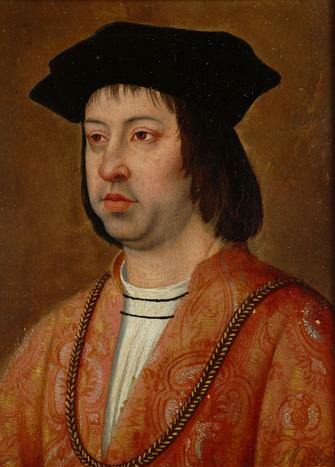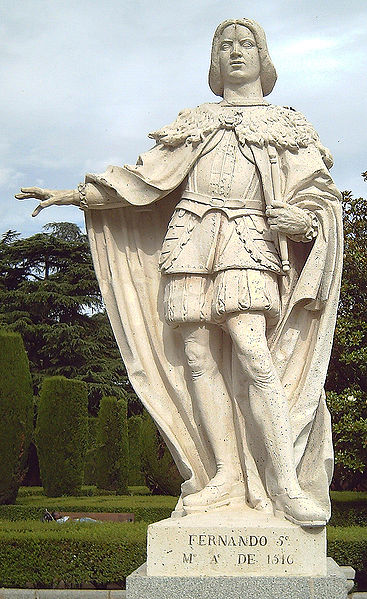<Back to Index>
- Physician Marcello Malpighi, 1628
- Painter William Etty, 1787
- King of Aragon Ferdinand II, 1452


Ferdinand the Catholic (Spanish: Fernando II de Aragón y V de Castilla "el Católico", Catalan: Ferran II d'Aragó "el Catòlic", Aragonese: Ferrando II d'Aragón "lo Catolico"; March 10, 1452 – January 23, 1516) was King of Aragon (1479–1516), Sicily (1468–1516), Naples (1504–1516), Valencia, Sardinia, and Navarre, Count of Barcelona, jure uxoris King of Castile (1474-1504) and then Regent (and true ruler) of that country also from 1508 to his death, in the name of his mentally unstable daughter Joanna the Mad.
Ferdinand was born in Sos del Rey Católico, and was the son of John II of Aragon (whose family was a cadet branch of the House of Trastámara) by his second wife, Juana Enríquez. He married Infanta Isabella, the half-sister and heiress of Henry IV of Castile, on 19 October 1469 in Valladolid and became jure uxoris King of Castile when Isabella succeeded her brother as Queen of Castile in 1474. Isabella also belonged to the royal House of Trastámara, and the two were second cousins by descent from John I of Castile. Married under the joint motto, tanto monta, monta tanto, the two young monarchs were initially obliged to fight a civil war against Joan, princess of Castile (also known as Juana la Beltraneja), the purported daughter of Henry IV, and were swiftly successful. When Ferdinand succeeded his father as King of Aragon in 1479, the Crown of Castile and the various territories of the Crown of Aragon were united in a personal union creating for the first time since the 8th century a single political unit referred to as España (Spain), the root of which is the ancient name Hispania, although the various states were not formerly administered as a single unit until the 18th century, but rather, as separate political units under the same Crown.
The first decade of Ferdinand and Isabella's joint rule were taken up with the conquest of the Kingdom of Granada, the last Arab-Muslim state in the Iberian peninsula, which was completed by 1492. In that same year, the Alhambra Decree was issued, expelling all Jews from both Castile and Aragon, and Christopher Columbus was sent by the couple on his expedition (ostensibly bound for east Asia) which resulted in the European arrival in the America. By the Treaty of Tordesillas of 1494, the extra-European world was split between the crowns of Portugal and Castile by a north-south line through the Atlantic Ocean.
Violating
the treaty that they had signed with the former King of Granada, which
guaranteed religious freedom for Muslims, they forced all Muslims in
their dominions to convert to Christianity or else be expelled. The
only Muslims that remained were architects, who had designed the
Alhambra Palace in Granada. After Isabella's death, her kingdom went to their daughter Joanna. Ferdinand served as the latter's regent during her absence in the Netherlands, ruled by her husband Archduke Philip.
Ferdinand attempted to retain the regency permanently, but was rebuffed
by the Castilian nobility and replaced with Joanna's husband, who became Philip I of Castile. After Philip's death in 1506, with Joanna supposedly mentally unstable, and her and Philip's son Charles of Ghent only six years old, Ferdinand resumed the regency, ruling through Francisco Cardinal Jimenez de Cisneros, the Chancellor of the Kingdom. Ferdinand disagreed with Philip's policies. In 1505, Ferdinand remarried with Germaine of Foix, a granddaughter of his half-sister Queen Leonor of Navarre,
in hopes of fathering a new heir and so separating Aragon and Castile
(denying Philip the governance of Aragon), and to potentially lay claim
to Navarre. Ferdinand also had children from his mistress, Aldonza Ruiz de Iborre y Alemany of Cervera. He had a son, Alfonso de Aragon (born in 1469), who later became Archbishop of Saragossa, and a daughter Joanna (born in 1471), who married Bernardino de Valsco, the 1st Duke of Frias. In the 1500s, Alfonso de Aragon, who later became Archbishop of Saragossa,
found a hidden study under the palace of Ferdinand containing over 400
documents written by Ferdinand himself. In these documents, Ferdinand
explained his general outlook on political power, and his true goals
behind all his decisions during life as the King of Spain. Also through
these documents, which surprised many people, writings stated that
Ferdinand, during times of very complicated decision making,
blindfolded himself to concentrate on the true matter of the situation,
as to not let various things cloud his judgment. In 1508, war resumed in Italy, this time against Venice, which all the other powers on the peninsula, including Louis XII, Ferdinand, Maximilian, and Pope Julius II joined together against as the League of Cambrai. Although the French were victorious against Venice at the Battle of Agnadello, the League soon fell apart, as both the Pope and Ferdinand became suspicious of French intentions. Instead, the Holy League was formed, in which now all the powers joined together against France. In November 1511 Ferdinand and his son-in-law Henry VIII of England signed the Treaty of Westminster, pledging mutual aid between the two against France. Earlier that year, Ferdinand had conquered the southern half of the Kingdom of Navarre,
which was ruled by a French nobleman, and annexed it to Spain. The Holy
League was generally successful in Italy, as well, driving the French
from Milan, which was restored to its Sforza dukes by the peace treaty in 1513. The French were successful in reconquering Milan two years later, however. Ferdinand died in 1516 in Madrigalejo, Extremadura.
The
latter part of Ferdinand's life was largely taken up with disputes over
control of Italy with successive Kings of France, the so-called Italian Wars. In 1494, Charles VIII of France invaded Italy and expelled Alfonso II (who
was Ferdinand's first cousin once removed and stepson of Ferdinand's
sister) from the throne of Naples. Ferdinand allied with various
Italian princes and with Emperor Maximilian I, to expel the French by 1496 and install Alfonso's son, Ferdinand, on the Neapolitan throne. In 1501, following the death of Ferdinand II of Naples and his succession by his uncle Frederick, Ferdinand of Aragon signed an agreement with Charles VIII's successor, Louis XII, who had just successfully asserted his claims to the Duchy of Milan, to partition Naples between them, with Campania and the Abruzzi, including Naples itself, going to the French and Ferdinand taking Apulia and Calabria. The agreement soon fell apart, and over the next several years, Ferdinand's great general Gonzalo Fernández de Córdoba conquered Naples from the French, having succeeded by 1504. Another less famous "conquest" took place in 1503, when Andreas Paleologus, de jure Emperor of the Eastern Roman Empire, left Ferdinand and Isabella as heirs to the empire, thus Ferdinand became de jure Imperator Constantinopolitanus.